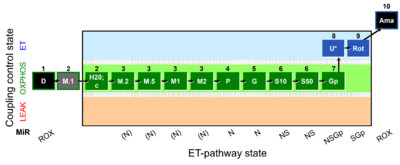Description
Abbreviation: FAO control & M kinetics
Reference: A - SUIT-038 - F-pathway and malate anaplerosis - control protocol
SUIT number: D091_1D;2M.1;2H2O;2c;3M.2;3M.5;3M1;3M2;4P;5G;6S10;6S50;7Gp;8U;9Rot;10Ama
O2k-Application: O2
The SUIT-038 O2 mt D091 protocol is focused on the analysis of the malate anaplerotic pathway control state in mitochondrial preparations such as isolated mitochondria, tissue homogenates and permeabilized cells (already permeabilized when they are added to the chamber) in a wide variety of species, tissues and cell types. Malate alone does not support respiration if oxaloacetate is not metabolized further in the absence of acetyl-CoA. The careful titration of malate is required to analyze the activity of the mt-isoform of NADP- or NAD(P)-dependent malic enzyme (mtME). If these enzymes are present in the sample one should be able to reach with malate alone a high respiratory activity comparable to the NADH-linked pathway control states with more classical combinations of substrates (e.g. PM or GM). Moreover, the pathway control in OXPHOS state ((N), N, NS, NSGp pathways) and in ET state (NSGp and SGp) can be evaluated by using this SUIT protocol.
Communicated by Grings M, Cecatto C and Cardoso LHD (last update 2023-04-12)
Representative traces
Steps and respiratory states
| Step | State | Pathway | Q-junction | Comment - Events (E) and Marks (M) |
|---|---|---|---|---|
| 1D | ROX | 1D
| ||
| 2M.1 | 1D;2M.1 | |||
| 2H2O | 1D;2M.1;2H2O
| |||
| 3c | 1D;2M.1;2H2O;2c
| |||
| 3M.2 | 1D;2M.1;2H2O;2c;3M.2
| |||
| 3M.5 | 1D;2M.1;2H2O;2c;3M.2;3M.5
| |||
| 3M1 | 1D;2M.1;2H2O;2c;3M.2;3M.5;3M1
| |||
| 3M2 | 1D;2M.1;2H2O;2c;3M.2;3M.5;3M1;3M2
| |||
| 4P | PMP | N | CI | 1D;2M.1;2H2O;2c;3M.2;3M.5;3M1;3M2;4P
|
| 5G | PGMP | N | CI | 1D;2M.1;2H2O;2c;3M.2;3M.5;3M1;3M2;4P;5G
|
| 6S10 | PGMSP | NS | CI&II | 1D;2M.1;2H2O;2c;3M.2;3M.5;3M1;3M2;4P;5G;6S10
|
| 6S50 | PGMSP | NS | CI&II | 1D;2M.1;2H2O;2c;3M.2;3M.5;3M1;3M2;4P;5G;6S10;6S50
|
| 7Gp | PGMSGpP | NSGp | CI&II&GpDH | 1D;2M.1;2H2O;2c;3M.2;3M.5;3M1;3M2;4P;5G;6S10;6S50;7Gp
|
| 8U | PGMSGpE | NSGp | CI&II&GpDH | 1D;2M.1;2H2O;2c;3M.2;3M.5;3M1;3M2;4P;5G;6S10;6S50;7Gp;8U
|
| 9Rot | SGpE | SGp | CII&GpDH | 1D;2M.1;2H2O;2c;3M.2;3M.5;3M1;3M2;4P;5G;6S10;6S50;7Gp;8U;9Rot
|
| 10Ama | ROX | 1D;2M.1;2H2O;2c;3M.2;3M.5;3M1;3M2;4P;5G;6S10;6S50;7Gp;8U;9Rot;10Ama
|
- Bioblast links: SUIT protocols - >>>>>>> - Click on [Expand] or [Collapse] - >>>>>>>
- Coupling control
- Pathway control
- Main fuel substrates
- » Glutamate, G
- » Glycerophosphate, Gp
- » Malate, M
- » Octanoylcarnitine, Oct
- » Pyruvate, P
- » Succinate, S
- Main fuel substrates
- Glossary
Strengths and limitations
- SUIT-038 provides a control protocol without fatty acids, to in combination with SUIT-036 and SUIT-037 study fatty acid oxidation (FAO) in a large variety of species, tissues and cell types. These protocols in combination allow:
- 1. to assess FAO carefully avoiding overestimation by endogenous substrates or malate anaplerosis.
- 2. to compare FAO with palmitoylcarnitine or octanoylcarnitine.
- 3. to analyse malate anaplerosis with malate kinetics
- 4. to analyse OXPHOS respiration and ET-capacity with various pathways (F, N, S, Gp)
- A succinate concentration of >10 mM may be required for saturating SE capacity.
- + SUIT-038 allows the depletion of endogenous substrates with ADP (1D).
- + Pathway control in OXPHOS (N, NS, NSGp pathways) and in ET state (NSGp and SGp) can be observed.
- + Multiple pathways converging into Q (NSGp) are assessed in OXPHOS and ET states. Therefore, P/E (7Gp/8U) at high ET capacity can be calculated.
- - Very long duration of the experiment.
- - LEAK state is not investigated.
Compare SUIT protocols
- SUIT-036_O2_mt_D089: Using palmitoylcarnitine to assess FAO - SUIT-038_O2_mt_D091 serves as a control protocol.
- SUIT-037 O2 mt D090: Using octanoylcarnitine to assess FAO - SUIT-038_O2_mt_D091 serves as a control protocol.
Chemicals and syringes
| Step | Chemical(s) and link(s) | Comments |
|---|---|---|
| 1D | ADP (D) | |
| 2M.1 | Malate (M) | |
| 2H2O | ||
| 2c | Cytochrome c (c) | |
| 3M.2 | Malate (M) | |
| 3M.5 | Malate (M) | |
| 3M1 | Malate (M) | |
| 3M2 | Malate (M) | |
| 4P | Pyruvate (P) | |
| 5G | Glutamate (G) | |
| 6S10 | Succinate (S) | |
| 6S50 | Succinate (S) | |
| 7Gp | Glycerophosphate (Gp) | |
| 8U | Carbonyl cyanide m-chlorophenyl hydrazone, CCCP (U) | Can be substituted for other uncoupler |
| 9Rot | Rotenone (Rot) | |
| 10Ama | Antimycin A (Ama) |
- Suggested stock concentrations are shown in the specific DL-Protocol.
References
- The project FAT4BRAIN has received funding from the European Union's Horizon 2020 research and innovation programme under grant agreement No 857394
Labels:
FAT4BRAINSUIT



